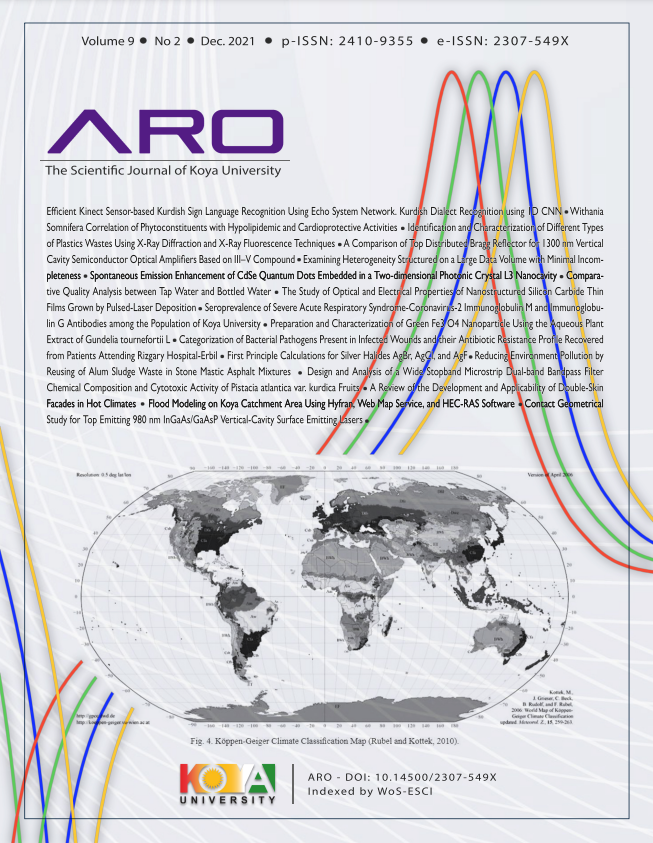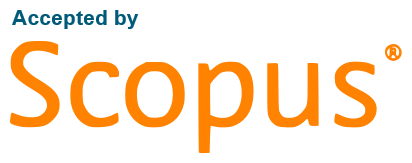Comparative Quality Analysis between Tap Water and Bottled Water
A Case Study of Koya City in Iraq
DOI:
https://doi.org/10.14500/aro.10870Keywords:
Dissolved oxygen, Total dissolved solid, Electrical conductivity, Potential hydrogen, Total alkalinityAbstract
Recently, bottled water consumption has been increasing significantly, even when the quality of tap water is considered excellent, which contributes to plastic pollution. Besides, reducing the use of plastic generally is recommended world widely, as its consumption is in an alarming rate. Therefore, this study aims to compare the tap and bottled water and manifest the reasons behind choosing the bottled water, which is less comfortable and often more expensive over the tap water. In this study, samples have been taken from both bottled and tap water in Koya city from November 2020 to May 2021 to test their quality using PH, DO, EC, and TDS meter, hardness was determined by complexometric titration method at 21°C, and XRF spectrometers. According to the quality standards, most of the variables were in a permissible range, except for dissolved oxygen and Aluminum content in both types of water and TDS for two types of bottled water. However, the quality of tap water was much safer to be used, as compared with the bottled water.
Downloads
References
Chapman, G., 1986. Ambient Water Quality Criteria for Dissolved Oxygen, EPA-440/5-86-003. U. S. Environmental Protection Agency, Washington, D.C. Available from: https://www.who.int/water_sanitation_health/resourcesquality/wpcchap2.pdf. [Last accessed on 10 Aug 2021].
Enderlein, U., Enderlein, R. and Williams, W., 1997. In: World Health Organization, editor. Water Pollution Control: A Guide to the Use of Water Quality Management Principles. E & FN Spon, London, pp.9-47. Available from: https://www.apps.who.int/iris/handle/10665/41967. [Last accessed on 10 Aug 2021].
Environmental Protection Agency (EPA) on pH and Alkalinity, 2006. Volunteer Estuary Monitoring a Methods Manual. 2nd ed. Environmental Protection
Agency, Washington, DC, United States, pp.185-196. Available from: https://www.epa.gov/sites/default/files/2015-09/documents/2007_04_09_estuaries_monitoruments_manual.pdf. [Last accessed on 10 Aug 2021].
Ferrier, C., 2001. Bottled water: Understanding a social phenomenon. AMBIO: A Journal of the Human Environment, 30(2), pp.118-119.
Hayashi, M., 2004. Temperature-electrical conductivity relation of water for environmental monitoring and geophysical data inversion. Environmental Monitoring and Assessment, 96, pp.119-128. Available from: https://www.link.springer.com/article. [Last accessed on 10 Aug 2021].
Meride, Y. and Ayenew, B., 2016. Drinking water quality assessment and its effects on resident’s health in Wondo genet campus, Ethiopia. Environmental Systems Research, 5(1), p.35.
Qian, N., 2017. Bottled water or tap water? A comparative study of drinking water choices on University Campuses. Water, 10(1), p.59.
Sen Gupta, A. and McNeil, B., 2012. Variability and change in the ocean. In: Henderson-Sellers, A. and McGuffie, K., editors. The Future of the World’s Climate. 2nd ed., Ch. 6. Elsevier, Boston, pp.141-165.
World Health Organization and International Programme on Chemical Safety, 1996. Guidelines for Drinking-Water Quality. 2nd ed., Vol. 2. World Health Organization, Geneva. Available from: https://www.file:///c:/users/high%20tech/downloads/9241544805.pdf. [Last accessed on 10 Aug 2021].
World Health Organization and International Programme on Chemical Safety, 2006. Guidelines for Drinking-Water Quality [Electronic Resource]: Incorporating First Addendum. 3rd ed., Vol. 1. World Health Organization, Geneva. Available from: https://www.who.int/water_sanitation_health/dwq/gdwq0506.pdf. [Last accessed on 10 Aug 2021].
World Health Organization and International Programme on Hardness in Drinking-Water, 2011. Guidelines for Drinking-Water Quality. World Health Organization Press, Geneva. Available from: https://www.who.int/water_sanitation_health/dwq/chemicals/hardness.pdf. [Last accessed on 10 Aug 2021].
Xianhong, Y., Shijun, L., Jian, H. and Jie, X., 2021. Application analysis of conductivity in drinking water quality analysis. IOP Conference Series: Earth and Environmental Science, 784(1), p.012028.
Downloads
Published
How to Cite
Issue
Section
License
Authors who choose to publish their work with Aro agree to the following terms:
-
Authors retain the copyright to their work and grant the journal the right of first publication. The work is simultaneously licensed under a Creative Commons Attribution License [CC BY-NC-SA 4.0]. This license allows others to share the work with an acknowledgement of the work's authorship and initial publication in this journal.
-
Authors have the freedom to enter into separate agreements for the non-exclusive distribution of the journal's published version of the work. This includes options such as posting it to an institutional repository or publishing it in a book, as long as proper acknowledgement is given to its initial publication in this journal.
-
Authors are encouraged to share and post their work online, including in institutional repositories or on their personal websites, both prior to and during the submission process. This practice can lead to productive exchanges and increase the visibility and citation of the published work.
By agreeing to these terms, authors acknowledge the importance of open access and the benefits it brings to the scholarly community.
Accepted 2021-10-16
Published 2021-11-08
















 ARO Journal is a scientific, peer-reviewed, periodical, and diamond OAJ that has no APC or ASC.
ARO Journal is a scientific, peer-reviewed, periodical, and diamond OAJ that has no APC or ASC.